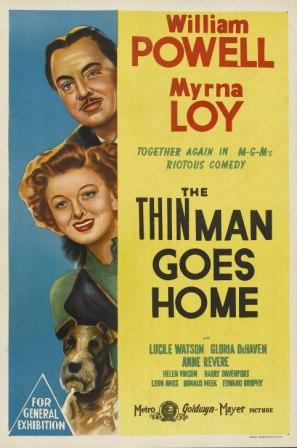“It is my belief, Watson, founded upon my experience, that the lowest and vilest alleys in London do not present a more dreadful record of sin that does the smiling and beautiful countryside.” —— Sherlock Holmes in The Adventure of the Copper Beeches by Sir Arthur Conan Doyle
The first of Nick and Nora Charles’ sleuthing adventures that dropped in on the world, and made such a surprise hit in 1934, was The Thin Man. While Christmas vacationing in New York City, Nick investigates the disappearance of a one-time client who ends up murdered. The victim, unidentifiable except for a war wound, is the actual “thin man,” but in the subsequent five detective films, Nick assumes the title without any difficulty, and it seems to fit perfectly.
The moviegoers in the 1930s had never seen anything like this portrayal of a sophisticated married couple who were . . . well, so happy. Nick and Nora carried on a carefree life, exchanged sexual innuendos and risqué barbs, all in fun, and despite the nightclubbing, the party-going, the seemingly endless drinking, there was still time to solve any number of murders, and never soil a sleeve or ruffle a dress.
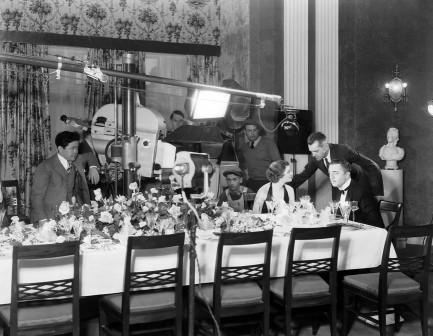 The success of that first film demanded more of the same, and the sequels were spaced far enough apart, about every two years, that their fans never tired of them and eagerly anticipated their next movie. If the subsequent efforts never equaled the original, even the weakest were brightened by the magic and charisma of the two stars, William Powell and Myrna Loy—and Asta their wire-haired terrier.
The success of that first film demanded more of the same, and the sequels were spaced far enough apart, about every two years, that their fans never tired of them and eagerly anticipated their next movie. If the subsequent efforts never equaled the original, even the weakest were brightened by the magic and charisma of the two stars, William Powell and Myrna Loy—and Asta their wire-haired terrier.
In the second film, After the Thin Man (1936), generally agreed to be the best of the sequels, the couple are back home in San Francisco, now on the trail of murder and intrigue in a Chinese nightclub. The film is notable, among other reasons, for newcomer James Stewart as one of the many suspects.
By 1939, Nick and Nora return to New York and now to a swanky Long Island estate in Another ThinMan. In tow is new arrival baby Nicky, Jr., born sometime since the last film. The friend of Nora’s father is receiving threats and requests Nick’s help, but not soon enough, as the man is murdered. Besides an excellent supporting cast, which changes from film to film, one of the highlights of this entry is the Afro-Cuban dance team of René Guillén and Ramona Ajón, popular headliners at the time.
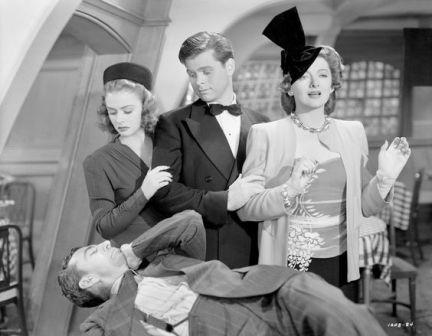 In Shadow of the Thin Man (1941), it’s the murder of a jockey at a race track that interrupts—only temporarily—the drinking and happy-go-lucky life. Besides Donna Reed in her second film and Barry Nelson’s début, Stella Adler, the distinguished acting teacher, has a part, not as any sort of teacher, but as a gambler’s moll. Sam Levene makes his second appearance in the series as Police Lieutenant Abrams, who remains two or three steps behind the debonair Nick Charles.
In Shadow of the Thin Man (1941), it’s the murder of a jockey at a race track that interrupts—only temporarily—the drinking and happy-go-lucky life. Besides Donna Reed in her second film and Barry Nelson’s début, Stella Adler, the distinguished acting teacher, has a part, not as any sort of teacher, but as a gambler’s moll. Sam Levene makes his second appearance in the series as Police Lieutenant Abrams, who remains two or three steps behind the debonair Nick Charles.
And so, after four Thin Man films, perhaps the producers felt Nick and Nora needed a radical change of scenery, away from the gangsters, the big, crime-torn cities and the glamorous but dangerous night spots. The Thin Man Goes Home is the first of the series not directed by W. S. “One-Take Woody” Van Dyke, who had died the previous year. The director is now Richard Thorpe. Also, the original Asta had outgrown the part, so a new terrier assumes the role, the most nuanced of acting differences apparently unnoticed by the critics.
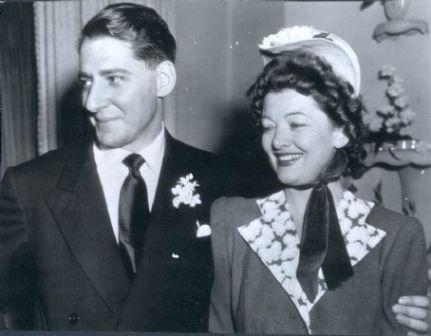 When this fifth film was being planned in early 1942, Myrna Loy refused to play wife to William Powell in another movie in the series. Irene Dunne was scheduled in her place. After marrying car rental heir John Hertz, Jr., and then becoming “available,” Loy returned in time for the May-to-July 1944 filming. Dunne, an entirely different type of actress, perhaps too ladylike for the requisite high jinks, is hard to imagine in the Nora role after Loy’s perfect casting in the part.
When this fifth film was being planned in early 1942, Myrna Loy refused to play wife to William Powell in another movie in the series. Irene Dunne was scheduled in her place. After marrying car rental heir John Hertz, Jr., and then becoming “available,” Loy returned in time for the May-to-July 1944 filming. Dunne, an entirely different type of actress, perhaps too ladylike for the requisite high jinks, is hard to imagine in the Nora role after Loy’s perfect casting in the part.
To at least round off the list, the last of the films in the series, Song of the Thin Man (1947), set in the jazz clubs of New York City, is the weakest of the six, though another impressive supporting cast includes Keenan Wynn, Gloria Graham and an eleven-year-old Dean Stockwell as Nicky, Jr.
The national presence of World War II is reflected in The Thin Man Goes Home—a lady’s war rationing stamp book at a butcher shop, a train station poster encouraging the citizenry to “do with less,” frequent men in uniform and, in accordance with the sobering times, a curtailing of much of the couple’s drinking and their repartee on the subject. In the film’s first scene, in fact, Nick mentions his “reform movement.” “A couple of weeks on this cider,” he tells Nora, “and I’ll be a new man.”
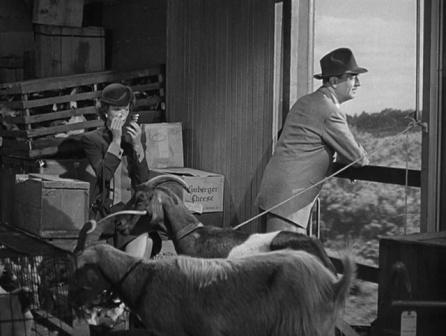 It is to the country, a little backwater town, that the couple journey by train to visit Nick’s parents in his hometown, Sycamore Springs. Nora attempts to smuggle Asta aboard the train, under her folded fur coat. Ironically, she implies it’s a baby and a passenger clears the way through the crowded coach. Ironic, perhaps, because Nicky, Jr., who should be about five or six by now, is not with his parents, nor is his absence explained. The dog is discovered and the three are relegated to the baggage car, along with miscellaneous crates, goats and caged fowl.
It is to the country, a little backwater town, that the couple journey by train to visit Nick’s parents in his hometown, Sycamore Springs. Nora attempts to smuggle Asta aboard the train, under her folded fur coat. Ironically, she implies it’s a baby and a passenger clears the way through the crowded coach. Ironic, perhaps, because Nicky, Jr., who should be about five or six by now, is not with his parents, nor is his absence explained. The dog is discovered and the three are relegated to the baggage car, along with miscellaneous crates, goats and caged fowl.
As the train approaches Sycamore Springs, Nick points to the passing “old windmill,” amazed that it’s still there and telling Nora it was a secret hiding place in his youth. Not coincidentally, an aspect of the windmill, as well as the war, will be essential in the mystery; the painting is what Alfred Hitchcock called the MacGuffin, an item, a formula, whatever, that everybody in the film is after.
Nick is greeted by a loving mother (Lucile Watson) and his physician father (Harry Davenport) who still thinks a private detective is a poor job for his son. Also greeting him is the aloof maid Hilda (Anita Sharp-Bolster), who in the end, after Nick’s astounding bit of detective magic, will ask for his autograph.
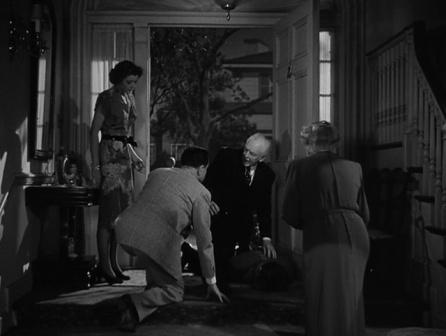 With an aircraft factory nearby, it’s not unusual when one of its workers, Peter Berton (Ralph Brooke), comes knocking at father Charles’ door. More unusual is that he drops dead before he can enter the house. The autopsy, performed by family friend, Dr. Bruce Clayworth (Lloyd Corrigan), reveals a pistol bullet in his back.
With an aircraft factory nearby, it’s not unusual when one of its workers, Peter Berton (Ralph Brooke), comes knocking at father Charles’ door. More unusual is that he drops dead before he can enter the house. The autopsy, performed by family friend, Dr. Bruce Clayworth (Lloyd Corrigan), reveals a pistol bullet in his back.
So easily, then, Nick Charles is off on another case—and, to no surprise, there are plenty of suspects. One is certainly “Crazy Mary” (Anne Revere), first seen at the train station when Nick and Nora arrive. She later knocks out Nick while he is searching Berton’s room.
Nick encounters quite a few other characters during his visit home, including an animated young lady, Laura Ronson (Gloria DeHaven), and her banking tycoon father (Minor Watson). Nick and Nora had first met Brogan (Edward Brophy) on the train, and though he turns up at the residence, sometimes hiding in the bushes, he seems harmless. Others are more intimidating: a gangster type, Studs Lonnegan (Tom Dugan); factory executive Willoughby (Morris Ankrum); and R.T. Tatum (Charles Halton), an employee of Ronson who warns Nick to stop meddling.
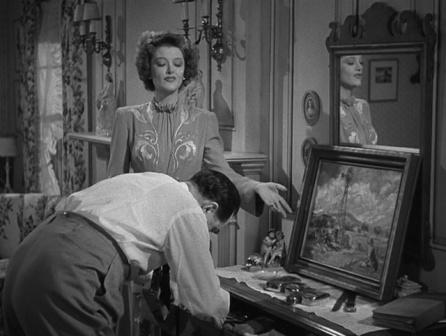 A focal point is the art gallery of Willie Crump (Donald Meek) where many individuals want a painting of that windmill. Nora buys it for Nick, thinking it would recall a cherished past, but he tells her it has unpleasant memories.
A focal point is the art gallery of Willie Crump (Donald Meek) where many individuals want a painting of that windmill. Nora buys it for Nick, thinking it would recall a cherished past, but he tells her it has unpleasant memories.
When Edgar and Helena Draque (Leon Ames and Helen Vinson) offer an exorbitant price for it, Nick becomes suspicious. The painting passes through various hands and is stolen on one occasion, Helenaleft unconscious. Nick learns that “Crazy Mary” is actually the mother of the murdered man, who had never known his mother’s identity. Later, she is found dead in her little shack where Asta sniffs out the painting.
In the finale, as in all the Thin Man films, Nick has the police round up all the suspects, and in Hercule Poirot style, conducts a summation of the case and the revelation of the killer. Nick intimates first one suspect then another as the killer of both Berton and “Crazy Mary.” Some simply act guilty, with shifty eyes, and one, Laura, says she has an appointment and attempts to leave. A search reveals a few guns, including Crump’s old flintlock pistol.
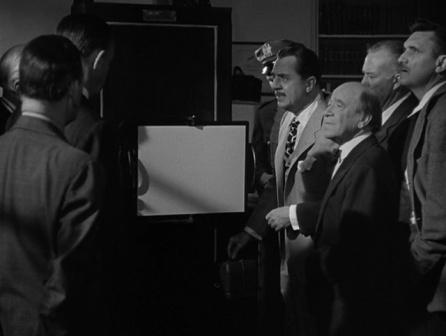 Using his father’s fluoroscope, Nick demonstrates that, hidden beneath the windmill painting, is one of five segments of a top secret plan for an airplane propeller manufactured by Ronson’s company, the other parts similarly concealed in four other paintings which Nick produces. Berton had hidden the plans there, intending to sell them to spies, but, changing his mind, had come to the Charles house to inform Nick when he was shot.
Using his father’s fluoroscope, Nick demonstrates that, hidden beneath the windmill painting, is one of five segments of a top secret plan for an airplane propeller manufactured by Ronson’s company, the other parts similarly concealed in four other paintings which Nick produces. Berton had hidden the plans there, intending to sell them to spies, but, changing his mind, had come to the Charles house to inform Nick when he was shot.
In the last and most incriminating evidence, it was not a pistol bullet which killed Berton, but a riflebullet from a Japanese sniper rifle with a silencer. It’s a definite link to the murderer, the seemingly least likely person, who turns out to be——
No spoiler here!
The Thin Man Goes Home is somewhat funnier than the previous films in the series. Nick and Nora frolic in a hammock. Later, she is in the middle of a merry follow-the-leader, she trailing Brogan and Edgar shadowing her—all accompanied by comic music in typical Mickey-Mousing fashion. Her walk through a pool hall earns her a few catcalls and whistles.
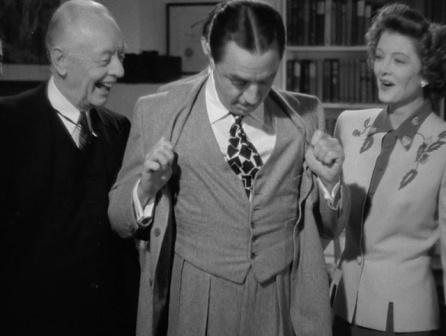 Soon after arriving at the Charles’ home, Nora regales Nick’s father with a long, convoluted story about how her brilliant husband solved a particular case, with the elder Charles’ endless uninterested interruptions. “There’s nothing Nick wants more,” she says at the end of her story, “than a pat on the back from his father. If he got that, he’d pop a button.”
Soon after arriving at the Charles’ home, Nora regales Nick’s father with a long, convoluted story about how her brilliant husband solved a particular case, with the elder Charles’ endless uninterested interruptions. “There’s nothing Nick wants more,” she says at the end of her story, “than a pat on the back from his father. If he got that, he’d pop a button.”
So, seventy-five minutes later, after Nick has solved the crime and the police have hauled away the murderer, his father does pat him on the back. “That was wonderful, Nick,” he says. “Great work, my boy.” And Nick smiles, leans back and a few buttons promptly pop from his stretched vest.
